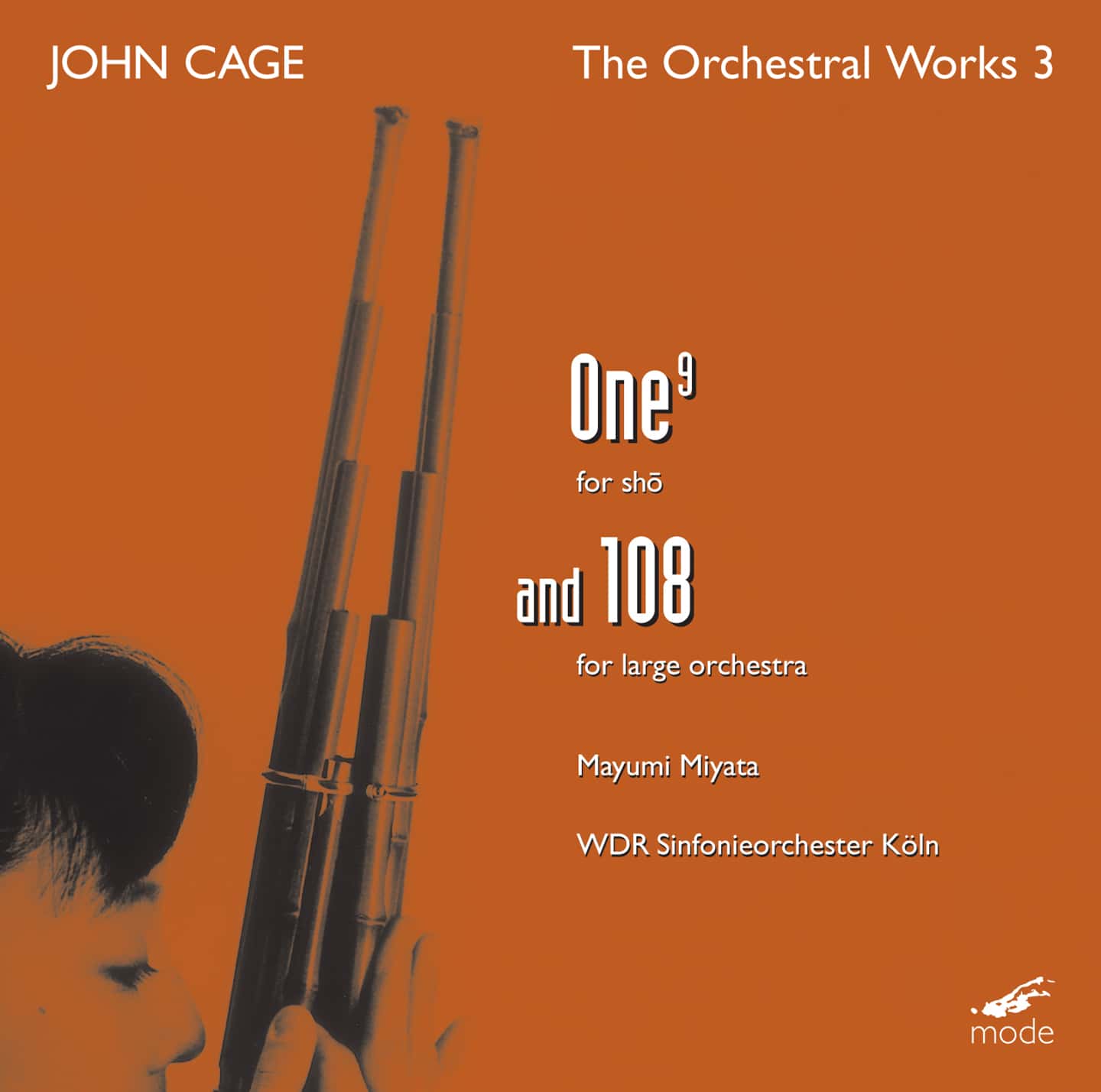Cage Edition 26–Orchestral Works 3
Previously released as a compact disc. (viewed Feb. 7, 2013). WDR Sinfonieorchester Köln ; Mayumi Miyata, conductor. Recorded in 2000.
Mayumi Miyata, sho
WDR Sinfonieorchester Köln
One9 for sho- (1991)
&
108 for large orchestra (1991) (43:30)
Played simultaneously
Cage scored 108 for the largest number of players in any of the Number Pieces – its duration of 43’30” makes an oblique reference to his groundbreaking 4’33” (1952). 108 can be played on its own or with either of two solo works from the same year, One8 (for cello) and One9 for the sho-, a mouth organ with bamboo pipes that acts as one of the harmony-producing instruments in Japanese gagaku. Both solo works were composed for artists very important in Cage’s final years – cellist Michael Bach (who can be heard on Mode 52) and Mayumi Miyata, who had pioneered the sho- as a contemporary concert instrument. Cage first met Miyata during his historic return to the 1990 Darmstadt summer course; enchanted with the sound of her instrument, Cage produced three works for her. (All of which will be recorded by Ms. Miyata on Mode.)
Cage always wanted to learn as many possibilities for a new instrument or medium as he could before composing a work, and among his papers are copious notes indicating all of the single tones and clusters that the sho- could play. Once this material was in place, he could then use chance operations to choose which of all these possibilities would become the sounds for his new pieces, thus producing results that he hoped would surprise and interest him when he finally heard them performed.
When One9 is performed with 108, it becomes a concerto – but a very unusual one, and a fine example of Cage’s aesthetic. The delicate sounds of the sho- enter almost imperceptibly, reminding one of Cage’s suggestion (in the performance notes for 101 [mode 41]) that tones be “brushed into existence as in oriental calligraphy where the ink (the sound) is not always seen, or if so, is streaked with white (silence).” The orchestra disappears entirely in two sections of the piece, but not to herald a grand cadenza: the sho- music continues much as it had before, a quiet, serene, almost timeless utterance. Indeed, the regal simplicity of the sho- makes it an ideal instrument for Cage, who tried to make his final work like writing on water – an action, incomparably graceful, that would leave no traces.
Liner notes are by Cage scholar Rob Haskins.
Reviews
John Cage
One9 for Sho; 108 for Large Orchestra
Mayumi Miyata (sho)
WDR Sinfonieorchester
Artistic Quality: 10
Sound Quality: 10
Mode 108
Two of John Cage’s compositions from 1991 are performed on Mode’s third volume of his orchestral works: One9 (for solo sho) and 108, written for large orchestra. These pieces, both of which belong to Cage’s “Number Pieces”, are not played sequentially on this recording–rather, they are played in tandem. Related to the Chinese sheng, the sho is a Japanese mouth organ with bamboo pipes that has an ethereal, otherworldly sound. Here, it’s played by the artist for whom Cage wrote his three sho pieces: Mayumi Miyata, who is recognized as one of the world’s premier sho players and most ardent champions. Her playing has a real elegance and quiet authority, and her orchestral partners are no less sensitive. As so much is dependent on their individual choices (for dynamics, or for range of time to sound a note), their acumen and taste is a crucial performance element–and the WDR players are up to the task, effectively distilling the sounds of their instruments to their essential qualities. Playing high notes, the violins are steely brightness personified, the clarinets are warm and woody, and the overall sensation is one of translucence. (The clarity of the details emerging from Cage’s landscape is attributable to Mode’s engineers, who capture both the highest and lowest ends of the sound spectrum without any distortion.)
Heard together, the pieces intertwine and separate in fascinating patterns–two distinct pieces relating to each other in a sort of dialogue or even confrontation. But another way of hearing One9 and 108 is as something of a concerto for sho and orchestra, albeit with its own unique structure. For one thing, the first minute and a half of the performance is entirely void of instrumental sound–it’s a far cry from the grand orchestral introductions of the Classical or Romantic concerto. Mode’s engineering translates the ambience of the Cologne Philharmonie with great attention to even the smallest sound. We hear the rattling, squeaking, and scraping of chairs in the hall in the silent sections, a clear reminder that Cage’s “silences” are never silent, nor are they meant to be.
— Anastasia Tsioulcas, www.classicstoday.com
Links
Also by Mayumi Miyata on Mode Records:
John Cage: Two4 with Irvine Arditti (violin) (mode 88)
Chaya Czernowin: Afatsim: Chamber Music (mode 77)
Cage on Mode:
Also available in the Cage ORCHESTRAL Series:
Orchestral Works 1: 101; Ryoanji; Apartment House – ensembles of New
England Conservatory, Stephen Drury (director) (mode 41)
Orchestral Works 2: Etcetera; Etcetera 2/4 Orchestras – ensembles of New
England Conservatory, Stephen Drury (director) (mode 86)
John Cage Profile/Discography
Mayumi Miyata Profile
WDR Symphony Orchestra Profile

